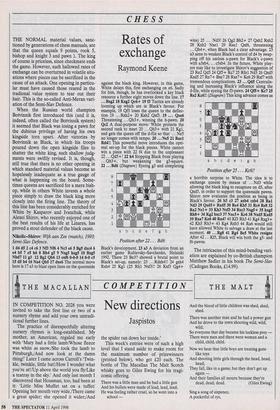CHESS
Rates of exchange
Raymond Keene
THE NORMAL material values, sanc- tioned by generations of chess manuals, are that the queen equals 9 points, rook 5, bishop and knight 3 and pawn 1. The king of course is priceless, since checkmate ends the game. However, such hallowed rates of exchange can be overturned in volatile situ- ations where pieces can be sacrificed in the cause of an attack. One opening in particu- lar must have caused those reared in the tradional value system to tear out their hair. This is the so-called Anti-Meran vari- ation of the Semi-Slav Defence.
When the Russian world champion Botvinnik first introduced this (and it is, indeed, often called the Botvinnik system) it seemed that Black was losing a pawn for the dubious privilege of having his own kingside torn apart. After victories by Botvinnik as Black, in which his troops poured down the open kingside files to shatter the white king, such shallow judg- ments were swiftly revised. It is, though, still true that there is no other opening in which standard material values become so hopelessly inadequate as a true gauge of what is happening on the board. Some- times queens are sacrificed for a mere bish- op, while in others White invests a whole piece simply to draw the black king more closely into the firing line. The theory of this line has been considerably enriched for White by Kasparov and Ivanchuk, while Alexei Shirov, who recently enjoyed one of the best results of his life at Linares, has proved a stout defender of the black cause.
Nikolic—Shirov: Wijk aan Zee (match), 1993; Semi-Slav Defence.
1 d4 d5 2 c4 c6 3 Nf3 Nf6 4 Nc3 e6 5 Bg5 dxc4 6 e4 b5 7 e5 h6 8 Bh4 g5 9 NxgS hxg5 10 Bxg5 Nbd7 11 g3 12 Bg2 Qb6 13 exf6 0-0-0 14 0.0 c5 15 d5 b4 16 Na4 Qb5 17 dxe6 The normal move here is 17 a3 to blast open lines on the queenside against the black king. However, in this game, White delays this, first exchanging on e6. Sadly for him, though, he has overlooked a key black resource a further eight moves down the line. 17 Bxg2 18 Kxg2 Qc6+ 19 f3 Tactics are already looming up which are in Black's favour. For example, 19 Qf3 loses the queen to the deflec- tion 19 Rxh2+ 20 Kxh2 Qxf3. 19 ... Qxe6 Threatening Qh3+, winning the h-pawn. 20 Qc2 A dual-purpose move: White protects the second rank to meet 20 ... Qh3+ with 21 Kgl, and gets the queen off the d-file so that ... Ne5 no longer comes with tempo. 20 ...Ne5 21 Rael Rd4i! This powerful move introduces the opti- mal set-up for the black pieces. White cannot win a piece with 22 f4 due to the unpleasant 22 ... Qd5 +! 22 h4 Stopping Black from playing Qh3+, but weakening the g3-square. 22 ...Bd6 (Diagram) Eyeing g3 and completing Black's development. 23 a3 A deviation from an earlier game Rublevsky–Savchenko, Helsinki 1992. There 23 Be3? showed a brutal point to Black's set-up, namely: 23 ...Rdxh4!! 24 gxh4 Rxh4 25 Kgl (25 Rh1 Nxf3!! 26 Kxf3 Qg4+
wins) 25 Nd3! 26 Qg2 Bh2+ 27 Qxh2 Rxh2 28 Kxh2 Nxel 29 Rxel Qxf6, threatening Qh4+, when Black had a clear advantage. 23 a3 aims to weaken Black's control of d4 by swap- ping off his useless a-pawn for Black's c-pawn
with a3xb4, c5xb4. In the future, White play- ers may like to investigate Shirov's suggestion of 23 Re2 Qd5 24 Qf5+ Kc7 25 Rfel Nd3 26 Qxd5 KxdS 27 Re7+ Bxe7 28 Rxe7+ Kc6 29 Rxf7 with tremendous complications. 23 ... Qd5 Centralis- ing and increasing Black's influence along the d-file, while eyeing the f3-pawn. 24 Qf5+ Kc7 25 Re2 Kc6:1 (Diagram) This king advance comes as Position after 25 . . Kc6!!
a horrible surprise to White. The idea is to exchange queens by means of ...Nd3 while allowing the black king to recapture on d5, after Qxd5, in order to support the queenside pawns. Shirov now evaluates the position as being in Black's favour. 26 b3 c3 27 axb4 cxb4 28 Ral Nd3 29 Qxd5+ Rxd5 30 Re4 Kb5 31 Rc4 Re8 32 Ra2 Nel+ 33 Kh3 Nxf3 34 Rxc3 Nxg5 + 35 hxg5 Rh8+ 36 Kg2 bxc3 37 Nxc3+ Kc6 38 NxdS KxdS 39 Rxa7 Ke6 40 Ra4? 40 Kf3 Rh3 41 Kg4 Rxg3+ 42 Ith5 Rh3+ 43 Kg4 Rxb3 44 Ra6 would still have allowed White to salvage a draw at the last moment. 40 ...Rg8 41 Rg4 Be5 White resigns After 42 Kf5, Black will win both the g5- and f6-pawns.
The intricacies of this mind-bending vari- ation are explained by co-British champion Matthew Sadler in his book The Semi-Slav (Cadogan Books, £14.99).


































































 Previous page
Previous page